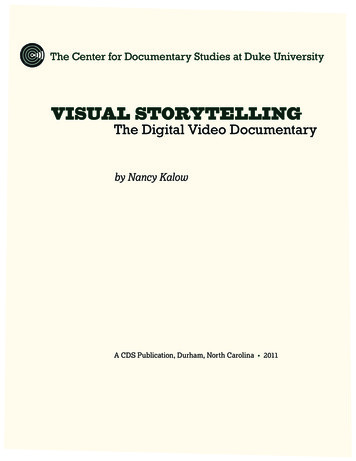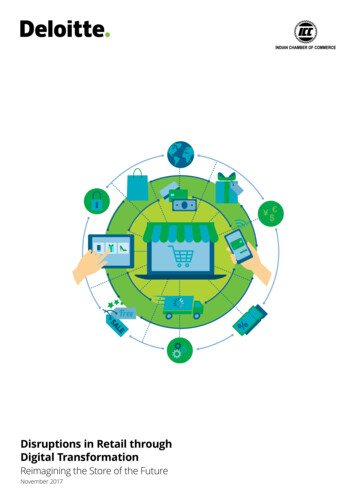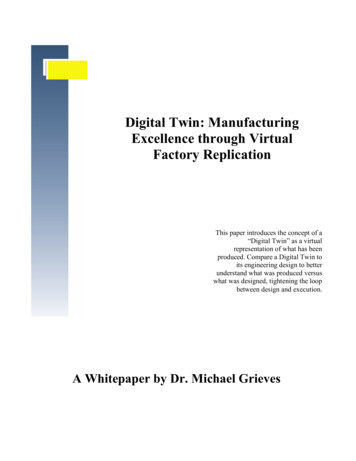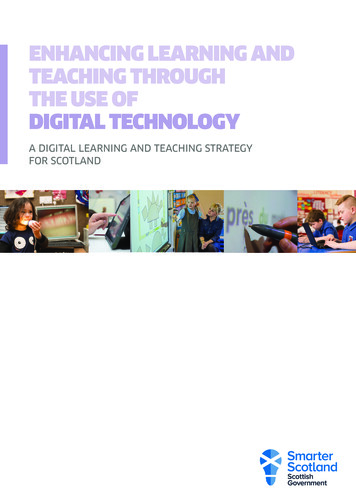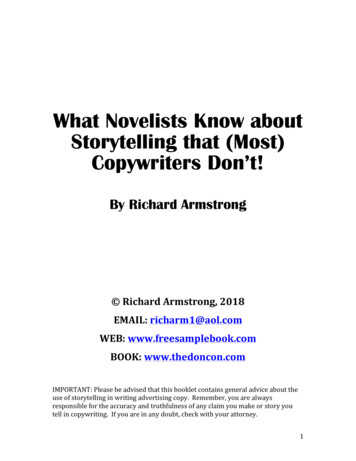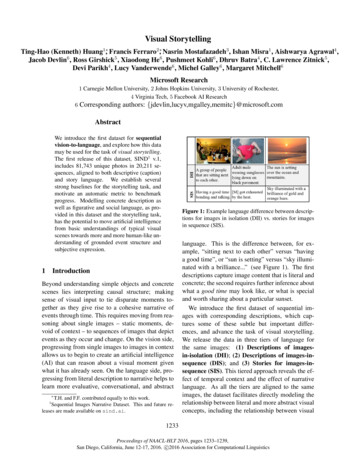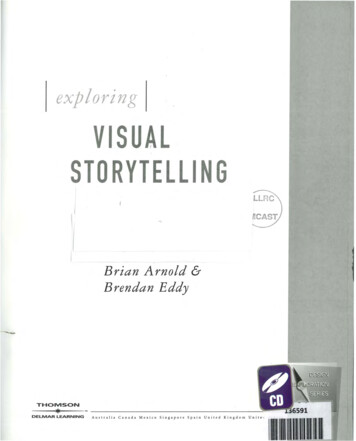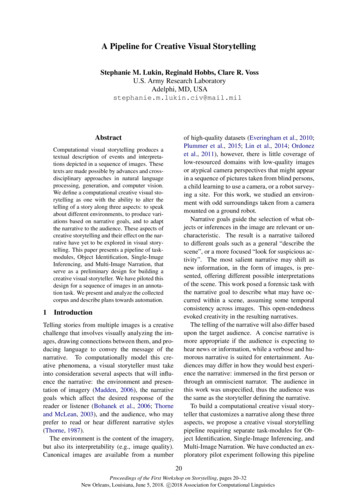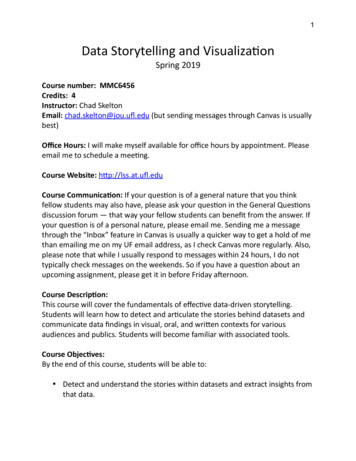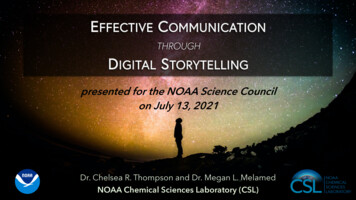
Transcription
EFFECTIVE COMMUNICATIONTHROUGHDIGITAL STORYTELLINGpresented for the NOAA Science Councilon July 13, 2021Dr. Chelsea R. Thompson and Dr. Megan L. MelamedNOAA Chemical Sciences Laboratory (CSL)
Dr. Chelsea R. Thompson- CSL Communications Lead and Graphic Designer with theCooperative Institute for Research in Environmental Science (CIRES)- Former research scientist in CSL Tropospheric Chemistry groupchelsea.thompson@noaa.govDr. Megan L. Melamed- CSL Scientific Advisor to the Director- Former Executive Director of the International Global AtmosphericChemistry (IGAC) Project- Former AAAS Science & Technology Policy Fellowmegan.melamed@noaa.gov
First, some context for this presentationCSL held its 5-year Science Review on February 23-25Due to COVID-19, we could not hold a traditional, in-personreview with PowerPoint presentations and postersInstead, we had to develop a new, virtual format tocommunicate our scienceWe relied almost exclusively on digital storytelling usingEsri StoryMaps for presenting our research.This approach received very positive feedback fromreviewers and stakeholdersThis is CSL’s first use of StoryMaps as a communications tool.Other NOAA Labs/Programs/Offices have used StoryMaps with muchsuccess. Our use is the first, to our knowledge, on the large scaleof a Science Review.
The ChallengeWe had to design an all-virtual Science Review that met the followingobjectives and criteria:1.Present a very large body of complex research on a wide range of topicsautonomously (without a presenter to explain or answer questions)2.Communicate complex research in a way that is accessible to range ofaudiences (incl. experts, non-experts, non-scientists, administrators)3.Communicate complex research in a way that is engaging to a range ofaudiences (no death by PowerPoint or PDF)4.5.Impress our audience by what we have done and create excitement forwhat is to comeAdded benefit: create valuable resources and content that can be usedbeyond the ReviewThese are the same challenges confronted in all sciencecommunication and outreach.The response to all of these challenges was heavy use of visual andinteractive content through digital storytelling.
So, what is digital storytelling?Digital storytelling refers to the use of digital multimedia to tell acompelling and emotionally engaging story.Digital stories combine a variety of communication and media elements,often within a narrative structure, and are typically interactive (throughscrolling and/or clicking) Photos, Graphics, ImageryVideosAnimationsMaps Charts, Graphs, and other DataVisualizations Links and/or Embedded WebContentThe effectiveness of digital storytelling for communication has beenrecognized by mass media in recent years, leading to growing popularityof interactive web content(see The Upshot section of the New York Times)
Trends in journalism & mass media can help to informour own communication strategiesChanging trends in information consumption (esp. science)NSF Science & Engineering Indicators Report:In 2018, 57% of Americans cited the Internet astheir primary source of Science and Technologyinformation; this has risen steadily from 9% in 2001.(Only 3% said Government Sources)Reuters 2019 Digital News Report:Consumers are becoming increasingly conscious ofthe time they are wasting online predict morepeople leaving social networks and focus on‘meaningful’ and higher quality content.“Organizations that consider the user experiencewill have more success.”Reuters/Oxford Journalism, Media, and TechnologyTrends for 2021:Survey respondents point to the need to focus more oninteraction and visual design.“Newsrooms will need to innovate in new digital formats ifthey are to successfully engage audiences on the platformswhere they choose to consume news.”
Benefits of digital storytelling for science communication1. Accessible to wider and more diverse audiences “Something for everyone” – different audiences prefer different content types and learn differently“Choose your own adventure” – Viewer can quickly gain insight on key takeaways OR can dive deeper intodifferent topics by watching videos, clicking links, exploring maps, etc.2. Engages people through multiple pathways simultaneously (text, visual, audio, interactivecontent) increases learning and information retentionexample of meeting someone at party3. Ideal for narrative communicationGrowing body of research showing that narrative communication (i.e., storytelling) is more effective for thanlogical-expository communication for science Narrative communication connects information with emotion – increases engagement and interestExpository (neutral)vs.“The queen died and then the king died.”Narrative“The queen died and then the king died of grief.” Narratives “humanize” the content, which in turn builds trust. Narrative format is the default cognition pathway for learning new information and storing to memory.
Our tool for the Science Review: Esri StoryMapsStoryMaps is a web-based tool from Esrifor digital storytellingStoryMaps is accessed through NOAA’sGeoPlatform on Esri (noaa.maps.arcgis.com)Login using your NOAA credentialsIn StoryMaps, you can view all NOAA-producedcontent under the “My Organization” tab.
CSL Science Review 14 StoryMaps in total, each created by a team of 3-4 researchersGuidance on structure and content by Chelsea & MeganContent review/editing by MeganTechnical support and video coordination by Chelseacsl.noaa.gov/reviews/2021/
StoryMap ExampleWild and Prescribed Fires
Esri StoryMaps softwareProsCons NOAA-wide Enterprise account (GeoPlatform) Free & accessible to all employees Easy to collaborate across Labs, Programs, and Line Offices Content ownership stays with NOAA, not lost to anemployee’s personal account on an external program Easy-to-learn graphical user interface (does not requireany advanced computer skills or progamming) Relatively flexible software; StoryMaps can be as simpleor as complex as you want Integrates with Esri’s traditional ArcGIS mappingcapabilitiesEsri StoryMaps is not the only digitalstorytelling software, but it does a goodjob balancing usability vs. featuresEasy to UseFeature-Rich Software limitations Does not (yet?) support any custom coding; Have towork within the StoryMap builder StoryMaps is not as established as the ArcGIS side ofEsri, so there are still some minor bugs and quirks. but, Esri is regularly adding new features and fixes(updates announced usually every few months) One-size-fits-all that doesn’t make everybodyhappy They take more time to produce, generally, then astandard webstory or article (but timeµ complexity)
Using StoryMaps for communicationsWhen to use StoryMaps To communicate multi-faceted topics, concepts, projects To communicate more complex topics where visuals are needed to add clarity andunderstanding To reach a larger range of audiences (incl. younger audiences) For more “evergreen” topics that span multiple projects and/or multiple LineOffices (e.g., hurricanes, climate, drought) State of the Science Fact Sheet topics would work very well for StoryMaps For topics in which we have a lot of visual assetsWhen NOT to use StoryMaps Quick news highlights Individual, stand-alone publicationsStoryMaps do not take the place of social mediaposts or NOAA Research webstories
Leveraging StoryMaps for OutreachA few ideas: Educational StoryMaps about NOAA research topics or field campaigns, withembedded photos, videos, scientist interviews, etc. Boulder Outreach Coordination Committee is working on several for newoutreach webpage Virtual lab tours (see AOML’s example) Storytelling competitions using NOAA data (see UN SDGs 2020 Competitionand National Geographic “Restoring Our Oceans” 2021 Competition) general public or student learning activity creating StoryMaps is also an effective learning tool; “teach students to be story tellers, not just story readers” “Crowdsourced” StoryMaps
ConclusionsStoryMaps have a lot of potential to be an effective and engaging toolfor both our Communications and Outreach.Interactive multimedia approach makes StoryMaps accessible to a widerange of diverse audiences.Narrative communication creates an emotional connection to thecontent, which increases information retention.Creating StoryMaps can be more time-consuming, and so are notappropriate for everything, but the extra time can be worth it.
We relied almost exclusively on digital storytelling using Esri StoryMapsfor presenting our research. . (no death by PowerPoint or PDF) 4. Impressour audience by what we have done and . confronted in all science communication and outreach. The response to all of these challenges was heavy use of v
